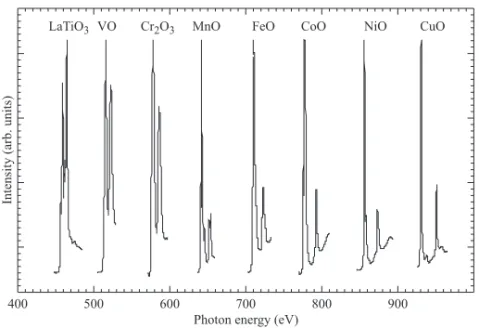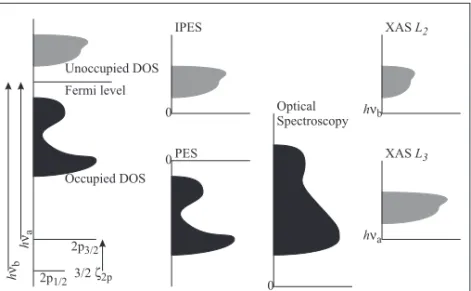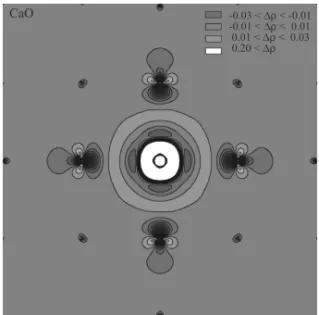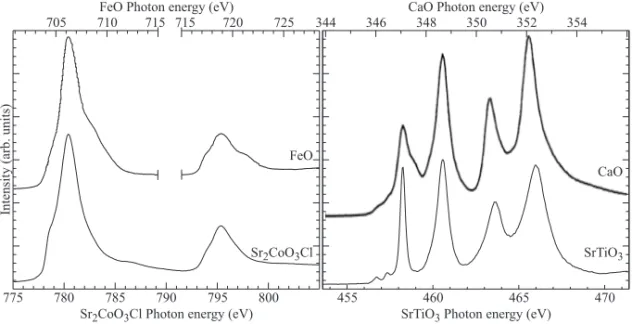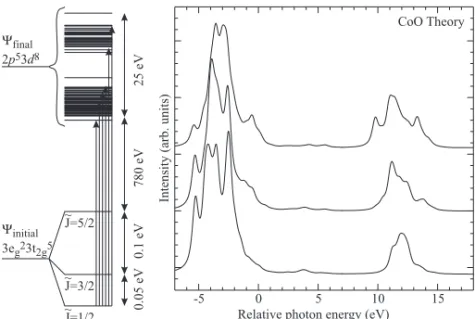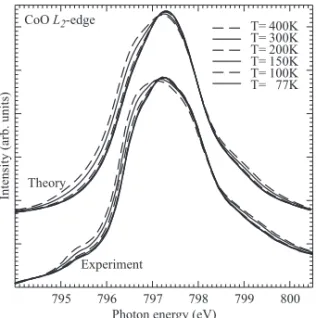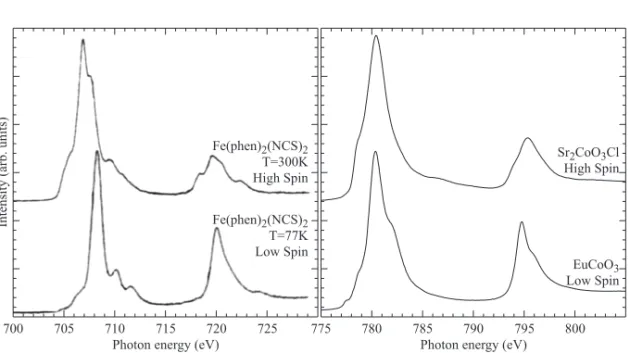Spin and orbital degrees of freedom
in transition metal oxides and oxide thin films studied by soft x-ray absorption spectroscopy
Maurits Haverkort
Spin and orbital degrees of freedom
in transition metal oxides and oxide thin films studied by soft x-ray absorption spectroscopy
Inaugural - Dissertation zur
Erlangung des Doktorgrades
der Mathematisch-Naturwissenschaftlichen Fakult¨ at der Universit¨ at zu K¨ oln
vorgelegt von Maurits W. Haverkort aus Swifterbant, Nederland
K¨ oln 2005
Prof. Dr. T. Hibma Prof. Dr. S. Bl¨ ugel
Tag der m¨ undlichen Pr¨ ufung:
07.06.2005
arXiv:cond-mat/0505214
Contents
1 Introduction 1
1.1 How to measure orbital occupations . . . . 2
1.2 Interpretation of x-ray absorption spectroscopy . . . . 2
1.3 The importance of full multiplet theory . . . . 5
1.4 Scope . . . . 13
2 X-ray absorption spectroscopy 17 2.1 One-electron theory . . . . 19
2.2 Excitons . . . . 21
2.3 Multiplets and selection rules . . . . 26
2.4 Polarization dependence . . . . 33
3 Cluster calculations 43 3.1 Constructing the basis . . . . 44
3.2 Many-electron wave-functions . . . . 44
3.3 Filling in the Hamilton matrix . . . . 45
3.4 One-electron Hamilton Operators . . . . 45
3.4.1 Crystal Field . . . . 46
3.4.2 Covalency . . . . 51
3.5 Two electron Hamiltonian Operators, electron-electron interaction 52 3.6 Spectroscopy . . . . 52
4 Sum-rules 55 4.1 Summery . . . . 64
5 Magnetic versus crystal field linear dichroism in NiO thin films Phys. Rev. B 69, 020408 (2004) 67 6 CoO 75 6.1 Crystal and magnetic structure of cobalt oxide. . . . 77
6.2 Experimental setup . . . . 78
momentum, and exchange coupling. . . . . 85 6.5 Linear dichroism; orbital occupation and spin direction. . . . 87 6.6 Spin direction in thin films of CoO under tensile or compressive
strain . . . 100 6.7 Electronic structure of CoO . . . 102 6.8 Conclusion . . . 107 7 Aligning spins in antiferromagnetic films using antiferromag-
nets 109
8 The spin-state puzzle in the cobaltates 117 8.1 Stabilization of the intermediate-spin state within cluster calcu-
lations . . . 121 8.2 Stabilizing the intermediate-spin state by band formation . . . . 123 8.3 Stabilizing the intermediate-spin state by Jahn-Teller distortions 126 8.4 Different look at the spin-state of Co 3+ ions in a CoO 5 pyramidal
coordination.
Phys. Rev. Lett. 92, 207402 (2004) . . . 128 9 Determination of the orbital moment and crystal field splitting
in LaTiO 3
Phys. Rev. Lett. 94, 056401 (2005) 137
10 Orbital-assisted metal-insulator transition in VO 2 145 A Slater integrals for 3 d and 4 d elements 153
B Source-code of A k,m 161
C Manual for XTLS 179
Abstract 187
Zusammenfassung 191
Acknowledgements 209
Erkl¨ arung 213
Publications 215
Curiculum vitae 217
Chapter 1
Introduction
The class of transition metal compounds shows an enormous richness of physical properties [1,2], such as metal-insulator transitions, colossal magneto-resistance, super-conductivity, magneto-optics and spin-depend transport. The theoretical description of these materials is still a challenge. Traditional methods using the independent electron approximation most of the time fail on even the sim- plest predictions. For example, many of the transition metal compounds, with NiO as the classical example, should be a metal according to band-structure calculations, but are in reality excellent insulators.
The single band Mott-Hubbard model [3, 4] explains very nicely why many correlated materials are insulating. But even the Mott-Hubbard model has some problems in describing the band-gap found for many of the transition metal compounds [5]. With the recognition that transition metal compounds can be of the charge-transfer type or the Mott-Hubbard type [6], depending on the ratio of U and ∆, also the band-gap can be understood. Hereby U is defined as the repulsive Coulomb energy of two electrons on the same transition metal site and ∆ is defined as the energy it costs to bring an electron from an oxygen site to a transition metal site.
The single band Mott-Hubbard model is, however, even when charge transfer effects are included, inadequate in describing the full richness found in many of the transition metal compounds [7–9]. It now becomes more and more clear that in order to describe transition metal compounds the charge, orbital, spin and lattice degrees of freedom should all be taken into account. Especially the orbital degrees of freedom have not been considered to the full extend until recently. In the manganates, for example, orbital and charge ordering of the Mn ions play an important role for the colossal magneto-resistance of these materials [10–14].
An other example would be the metal-insulator transition in V 2 O 3 [15–17]. The orbital occupation of the V ion changes drastically at the phase transition [15].
This change in orbital occupation will change the local spin-spin correlations
which in-turn will change the effective band-width. This indicates that not only electron-electron Coulomb repulsion in a single band must be considered, but a full multi-band theory including all interactions must be considered in order to understand this prototypical Mott-Hubbard system.
1.1 How to measure orbital occupations
With the recognition that the local orbital occupation plays an important role in many of the transition metal compounds there is a need for experimental techniques that can measure the orbital occupation. This technique is soft x-ray absorption spectroscopy. For transition metal atoms one measures the local transition of a 2 p core electron into the 3 d valence shell. This type of spectroscopy has only developed into maturity over the last 20 years, both in terms of instrumentation as well as in terms of theoretical understanding of these spectra [18–20]. The pioneering work of Fink, Thole, Sawatzky and Fug- gle, who used electron energy loss spectroscopy on narrow band and impurity systems has been very important for the development of soft x-ray absorption spectroscopy. They recognized, that the observed multiplet structures can pro- vide an extremely detailed information about the local electronic structure of the ground and lower excited states of the system [21–23].
The 2 p core-electron excitation into the 3 d shell is dipole allowed. This has, first of all the advantage that good intensities are found. The locally dipole allowed transition has also the advantage of obeying the strict dipole selec- tion rules. This means that the intensity found for a given final-state depends strongly on the symmetry of the initial state. In most cases the dependence on the initial state symmetry is so large that one does not need to have good resolution in order to determine which of the possible states is realized as the ground-state. Within chapter 2 we will show many examples taken from the lit- erature of what can be measured with the use of x-ray absorption spectroscopy and how these dipole selection rules are active.
1.2 Interpretation of x-ray absorption spectros- copy
For the interpretation of 2 p x-ray absorption spectra cluster calculations are
an essential tool. At the moment cluster calculations are still one of the best
methods to describe both near ground-state properties and spectra of transi-
tion metal compounds. This might seem surprising while cluster calculations
are not ab-inito and the translational symmetry of the solid is not taken into
account. There are two reasons why cluster calculations are so powerful. The
first reason is that within cluster calculations the initial state and the final state
1.2 Interpretation of x-ray absorption spectroscopy 3
are treated on an equal footing. This results in calculated spectra that can be compared to experiments in great detail. This is in strong contrast to density functional methods or Hartree-Fock methods which produce density of states and not spectra. One should realize that a density of states is not a spectrum.
The second reason is that within cluster calculations the full electron-electron repulsion Hamiltonian can be included. The importance of full multiplet theory for the description of transition metal compounds will be stressed within the next section.
Part of the breakthrough in the understanding of 2 p x-ray absorption spec- troscopy on transition metal compounds was realized with the creation of good computation codes that can calculate the spectra of a cluster. Here the work done by Theo Thole [18, 21] and Arata Tanaka [24] must be mentioned who both wrote a program able to do cluster calculations and calculate the x-ray absorption spectra with all its multiplet structure up to great detail.
Initial state PES final state XAS final state
d n d n+1 L d n+2 2 L
∆
∆+U dd
d n-1 d n L d n+1 2 L d n+2 3 L
∆-U dd
∆
∆+U dd
pd n+1 p d n+2 L p d n+3 2 L
∆+U -U dd dp
∆+2U dd dp -U 2p-core level
PES final state
pd n p d n+1 L p d n+2 2 L p d n+3 3 L
∆-U dp
∆+U -U dd dp
∆+2U dd dp -U
Figure 1.1: On-site energies of the bare configurations for the initial state and different final states. ∆ is the energy it costs to hop with one electron from the oxygen band to the transition metal d shell. U is the repulsive Coulomb energy between two electrons in the 3 d shell ( U dd ) or between a 3 d electron and a 2 p core electron ( U dp ). L denotes the oxygen or ligand states and L n stands for n holes in the ligands. The holes in the p shell for the 2 p -core level PES final states and for the XAS final states are holes in the 2 p -core level of the 3 d transition metal ions. Scheme taken from J. Zaanen, G. A. Sawatzky and J. W.
Allen [6].
The cluster calculations are done within the configuration interaction scheme,
allowing for the inclusion of hybridization of the transition metal d orbitals with the oxygen p orbitals [25–27], denoted as the ligand orbitals ( L ). The on-site energies are parameterized with U and ∆ in the same way as done by J. Zaa- nen, G. A. Sawatzky and J. W. Allen [6]. In figure 1.1 we show the energy level diagram for the initial state and the final states of valence-band photo-electron spectroscopy, 2 p -core level photo-electron spectroscopy and 2 p -core level x-ray absorption spectroscopy. For the last two spectroscopies, the 2 p -core levels are core levels of the transition metal ions. For the initial state only the few lowest states are important. For the final state in principle all different configurations can be reached and are therefore important. The intensity of each final state does depend on the dipolar matrix elements between the initial state wave func- tion and the final state wave-function under consideration. In order to reproduce the measured x-ray absorption spectra one has to have the correct final state as well as the correct initial state within the cluster calculation. This means that detailed information concerning the initial-state can be obtained once the spectrum has been reproduced.
In figure 1.1 we only showed the on-site energies of the different configu- rations. The configurations will be split into different states. First of all the hybridization of different orbitals is not equal. For a transition metal in O h
symmetry the e g orbitals hybridize more with the oxygen orbitals then the t 2 g
orbitals. States with more holes in the e g shell will therefore be more covalent and have different energies than states where the e g orbitals are occupied. Sec- ond there will be a splitting due to the crystal field. Within mean-field theory this crystal field originates from the electric field made by the charges of the atoms that surround the atom under consideration. For transition metal oxides the oxygen atoms are charged negative and the electrons at the metal site do want to point away from the oxygen atom. Within O h symmetry this means that the t 2g orbitals are lowered with respect to the e g orbitals. Third there will be a splitting between the different states within one configuration due to the electron-electron repulsion. The importance of electron-electron repulsion and the effect of screening for 3 d elements will be discussed within the next section. Forth there are the spin-orbit coupling and magnetic interactions that split the different states within one configuration. Within a cluster calculation these interactions can be included and for many systems have to be included in order to reproduce the x-ray absorption spectra properly.
Besides cluster calculations there is an other way to deduce information from
x-ray absorption spectra. B. T. Thole, P. Carra et al. [28, 29] have derived sum-
rules that relate the total integrated intensity of polarized spectra to expectation
values of some operators of the initial state. These sum-rules are very powerful
due to there simplicity of use.
1.3 The importance of full multiplet theory 5
1.3 The importance of full multiplet theory
One might expect that within a solid the multiplet splitting due to electron- electron repulsion is largely screened. For the monopole part of the electron- electron repulsion this is indeed true. If one adds an extra charge to one atom within the solid the charges of the surrounding atoms (or other shells of the same atom) will change and thereby lower the total repulsion the added charge feels. This type of screening is also found experimentally. We define U av as the local average repulsion between two electrons. U av can be related to the Slater Integrals, F 0 , F 2 and F 4 . The expression then becomes; U av = F 0 −
441 14 ( F 2 + F 4 ). This U av is within a solid much smaller than the Hartree-Fock value found for a free ion. Take Co 2+ in CoO for example. The Hartree-Fock value of U av for the free ion is about 25 eV. The U av experimentally found is about 6.5 eV [24].
Surprisingly the multiplet splitting within a configuration in the solid is ex- perimentally found not to be reduced from the free ion multiplet splitting. E.
Antonides, E. C. Janse and G. A. Sawatzky [30] did Auger spectroscopy on Cu, Zn, Ga and Ge metal and found that the F 2 and F 4 Slater integrals, the param- eters describing the multiplet splitting between states with the same number of electrons are in reasonable agreement with Hartree-Fock calculations on a free ion. This implies that only F 0 can be efficiently screened. These findings have been confirmed on many transition metal compounds [20, 26, 27, 31–34]. This absence of screening for the multiplet part of the electron-electron interaction can be understood if one realizes that the multiplet splitting is due to the differ- ent shape of the local electron cloud and\or due to different spin densities. Such differences are very difficult to screen by charges located externally. Moreover, there are also even states that have the same spin-resolved electron density ma- trix, d † mσ d m 0 σ 0 , but very different electron-electron repulsion interaction. Take a Ni 2+ ion for example. The 3 F M L =±3 ,M S =0 state, which belongs to the 21 fold degenerate ground-state, and the 1 G M L =±3 ,M S =0 state have the same electron density matrix d † mσ d m 0 σ 0 but an energy difference of 12 49 F 2 + 441 10 F 4 . Within a mean-field approximation it is not possible to screen this splitting since these states have the same electron densities.
The full electron-electron interaction Hamiltonian is give by [31, 35, 36]:
H e − e = X
hmm 0 m 00 m 000 σσ 0 i
U mm 0 m 00 m 000 σσ 0 l † mσ l 0† m 0 σ 0 l m 00 00 σ l 000 m 000 σ 0 (1.1)
with:
U mm 0 m 00 m 000 σσ 0 = δ ( m + m 0 , m 00 + m 000 ) X ∞
k=0
hlm|C m−m k 00 |l 00 m 00 ihl 000 m 000 |C m k 000 −m 0 |l 0 m 0 iR k ( ll 0 l 00 l 000 )
R k ( ll 0 l 00 l 000 ) = e 2 Z ∞
0
Z ∞
0
r k <
r > k+1
R n l ( r 1 ) R n l 0 0 ( r 2 ) R n l 00 00 ( r 1 ) R n l 000 000 ( r 2 ) r 1 2 r 2 2 δr 1 δr 2
(1.2) With r < = Min( r 1 , r 2 ) and r > = Max( r 1 , r 2 ). This Hamiltonian describes a scattering event of two electrons. These two electrons have before scattering the quantum numbers m 00 , m 000 , σ and σ 0 . After the scatter event they have the quan- tum numbers m, m 0 , σ and σ 0 . The scatter intensity is given by U mm 0 m 00 m 000 σσ 0 . The angular dependence can be solved analytically and is expressed in integrals over spherical harmonics. The radial part can not be solved analytically and is expressed in terms of Slater integrals over the radial wave equation; R k ( ll 0 l 00 l 000 ).
For two d electrons interacting with each other, the only important values of k are k = 0 , 2 or 4. For these k values the radial integrals are expressed as F 0 , F 2 and F 4 .
Many calculations done on solids containing transition metal ions do not include the full electron-electron Hamiltonian, but make an approximation. The simplest approximation that one can make is to describe the electron-electron repulsion by two parameters U 0 and J H , in which U 0 is the repulsive Coulomb energy between each pair of electrons and J H is the attractive Hund’s rule exchange interaction between each pair of electrons with parallel spin. This leads to the following Hamiltonian:
H e Simple − e = U 0
X
h mm 0 σσ 0 i
l † mσ l 0† m 0 σ 0 l mσ l 0 m 0 σ 0
−J H
X
hmm 0 σi
l † mσ l 0† m 0 σ l mσ l 0 m 0 σ
(1.3)
This Hamiltonian is built up entirely by number operators n mσ = l † mσ l mσ , and is therefore diagonal in the basis vectors that span the full electron-electron Hamiltonian.
This extremely simple Hamiltonian leads for the Hund’s rule high-spin ground-
state to remarkably good results [38]. In table 1.1 we compare the total energy of
a d n configuration ( n = 0 ... 10) calculated using the full multiplet theory to that
calculated using the simple scheme. To facilitate the comparison, we have rewrit-
ten the Slater integrals, F 0 , F 2 and F 4 in terms of U 0 = F 0 , J H = 14 1 ( F 2 + F 4 )
and C = 14 1 ( 9 7 F 2 − 5 7 F 4 ). We now see that the simple scheme is even exact
in half of the n cases and has an error of C for the other cases. Whereby the
Hartree-Fock value of C ranges from 0.5 eV for Ti 2+ to 0.8 eV for Cu 2+ .
1.3 The importance of full multiplet theory 7
Coulomb energy of Hund’s rule ground-state
Full Hamiltonian Simple Kanamori Kanamori mean field
d 0 0 0 0 0 0
d 1 0 0 0 0 0
d 2 F 0 - 49 8 F 2 - 441 9 F 4 U 0 - J H -C U 0 - J H U’ - J U’ - J d 3 3F 0 - 15 49 F 2 - 441 72 F 4 3U 0 - 3J H -C 3U 0 - 3J H 3U’ - 3J 3U’ - 3J d 4 6F 0 - 21 49 F 2 - 189 441 F 4 6U 0 - 6J H 6U 0 - 6J H 6U’ - 6J 6U’ - 6J d 5 10F 0 - 35 49 F 2 - 315 441 F 4 10U 0 -10J H 10U 0 -10J H 10U’ -10J 10U’ -10J d 6 15F 0 - 35 49 F 2 - 315 441 F 4 15U 0 -10J H 15U 0 -10J H 14U’+ U-10J 14U’+ U-10J d 7 21F 0 - 43 49 F 2 - 324 441 F 4 21U 0 -11J H -C 21U 0 -11J H 19U’+2U-11J 19U’+2U-11J d 8 28F 0 - 50 49 F 2 - 387 441 F 4 28U 0 -13J H -C 28U 0 -13J H 25U’+3U-13J 25U’+3U-13J d 9 36F 0 - 56 49 F 2 - 504 441 F 4 36U 0 -16J H 36U 0 -16J H 32U’+4U-16J 32U’+4U-16J d 10 45F 0 - 70 49 F 2 - 630 441 F 4 45U 0 -20J H 45U 0 -20J H 40U’+5U-20J 40U’+5U-20J
Table 1.1: Energy of the Hund’s rule ground-state of a d n electron configura- tion for different schemes. The relation between the Slater integrals F 0 , F 2 and F 4 and the parameters U 0 , J H , C , U 0 , U , J , J 0 is: U 0 = F 0 , J H = 14 1 ( F 2 + F 4 ), C = 14 1 ( 9 7 F 2 − 5 7 F 4 ), U 0 = U − 2 J , J 0 = J , U = F 0 + 49 4 F 2 + 441 36 F 4 and J = 2.5 49 F 2 + 22.5 441 F 4 [37, 38]. The center of each multiplet for the full Hamilto- nian is E av ( d n ) = ( F 0 − 441 14 ( F 2 + F 4 )) n ( n 2 −1) .
Effective Coulomb interaction U ef f for Hund’s rule ground-state Full Hamiltonian Simple Kanamori Kanamori
mean field d 1 F 0 - 49 8 F 2 - 441 9 F 4 U 0 - J H -C U 0 - J H U’- J U’- J d 2 F 0 + 49 1 F 2 - 441 54 F 4 U 0 - J H +C U 0 - J H U’- J U’- J d 3 F 0 + 49 1 F 2 - 441 54 F 4 U 0 - J H +C U 0 - J H U’- J U’- J d 4 F 0 - 49 8 F 2 - 441 9 F 4 U 0 - J H -C U 0 - J H U’- J U’- J d 5 F 0 + 14 49 F 2 + 126 441 F 4 U 0 +4J H U 0 +4J H U+4J U+4J d 6 F 0 - 49 8 F 2 - 441 9 F 4 U 0 - J H -C U 0 - J H U’- J U’- J d 7 F 0 + 49 1 F 2 - 441 54 F 4 U 0 - J H +C U 0 - J H U’- J U’- J d 8 F 0 + 49 1 F 2 - 441 54 F 4 U 0 - J H +C U 0 - J H U’- J U’- J d 9 F 0 - 49 8 F 2 - 441 9 F 4 U 0 - J H -C U 0 - J H U’- J U’- J
Table 1.2: The effective Hubbard U between lowest Hund’s rule ground-state multiplets for different approximation schemes. The relation between the Slater integrals F 0 , F 2 and F 4 and the parameters U 0 , J H , C , U 0 , U , J , J 0 is: U 0 = F 0 , J H = 14 1 ( F 2 + F 4 ), C = 14 1 ( 9 7 F 2 − 5 7 F 4 ), U 0 = U −2 J , J 0 = J , U = F 0 + 49 4 F 2 +
441 36 F 4 and J = 2.5 49 F 2 + 22.5 441 F 4 [37, 38]. The average U for the full Hamiltonian
is: U av = F 0 − 441 14 ( F 2 + F 4 ).
This remarkable accuracy is important for the study of the conductivity gap in Mott-Hubbard insulators. The energy gap to move an electron from one site to another site far away is given by U :
U ( d n ) = E ( d n −1 ) + E ( d n +1 ) − 2 E ( d n ) (1.4) If multiplet effects are important, then there will be many different manners to move the electron. The gap is equal to the cheapest way to move one electron from one site to another site far away and thus given by the U = U ef f. , which involves the lowest multiplet states and not by U av , which refers to the the multiplet average energies. In table 1.2 we have listed U ef f for the various d n configurations ( n = 1 ... 9), having the high-spin Hund’s rule ground-state. We can see here that the correspondence between the simple scheme and the full- multiplet theory is very good. The deviation is not more than C ≈ 0 . 5 ... 0 . 8 eV, which is quite acceptable since the accuracy in the determination of U 0 by experiment or calculation is of the same order.
The shortcomings of the simple scheme do, however, show up dramatically when we have to consider the presence of states other than the Hund’s rule ground-state. In figure 1.2 we show the energy level diagram for the d n config- uration ( n = 2 ... 5), in spherical symmetry as an example. We can see that the multiplet splitting within the simple scheme is very different from that within the full multiplet theory. This first of all means that the simple scheme is com- pletely useless for calculating high energy excitations, like soft-x-ray absorption spectra. One truly needs the full multiplet theory to explain the many sharp structures observed in experiments [20, 26, 27, 30–34]. Not only for spectroscopy the simple scheme is inadequate, also for calculating ground-state properties, such as the magnetic susceptibility: the multiplicities are quite different. Within the simplified scheme only the magnetic angular spin momentum S z is a good quantum number, whereas in the full electron-electron repulsion Hamiltonian also the angular momenta of spin and orbital moment, S and L , are good quan- tum numbers. In other words the simple scheme brakes symmetry. It is almost needles to state that the simple scheme is by far to inaccurate to calculate, the relative stability of, for instance, the different spin-states within a partic- ular configuration. Figure 1.2 shows clearly that the energy levels in the two schemes differ by many electron volts.
In order to improve on the simple scheme, but still simplify the full electron-
electron Hamiltonian we will have a look at the simplification as proposed by
J. Kanamori. He proposed a simplification that tries to preserve the multiplet
character of the electron-electron interaction as much as possible. The approxi-
mation he made is that the electron-electron scattering events can be expressed
in terms that only depend on wether the scattered electrons are in the same
band (orbital) or in different bands (orbitals). The Hamilton found by these
1.3 The importance of full multiplet theory 9
Full multiplet Simple
scheme Kanamori scheme
3 P
S = 1 z + 3 F
1 S
1 G
1 D S =0 z
(21) (9) (9) (1)
(5)
(20) (25)
(30) (14) 10 (1)
8
6
4
2 12
Multiplet ener gy (eV)
d configuration 2 d configuration 3
18
16
14
12
Multiplet ener gy (eV)
20
10
(10)
(14)
(10) (18)
(28) (28) (12)
(100)
(20) (40)
(70) (10)
S = z + 2 3 S = z + 2 1
4 F 4 P 2 G 2 H
&2 P 2 D 2 F 2 D
Multiplet ener gy (eV) Multiplet ener gy (eV)
22 24 26 28 30 32 34 36
38 40 42 44 46 48 50 52 1 S
1 D
1 G
5 D
2 D 2 P
2 G
6 S S = 2 z +
S = 1 z +
S =0 z S = z + 2 3
S = z + 2 5 S = z + 2 1
(6) (56) (40) (70) (70) (10)
(2) (200)
(50)
(6) (18) (6) (10)
(25) (105) (35) (30) (14) (1)
(25) (9) (5) (1)
(10) (100) (100)
Kanamori scheme mean-field
S=1 S=0 S=0
S = 1 z + S =0 z S =0 z
(20) (20) (10)
S= 3 2 S= 1 2 S= 1 2
S = z + 2 3 S = z + 2 1 S = z + 2 1
(20) (60) (40) Full multiplet Simple
scheme Kanamori
scheme Kanamori scheme mean-field
Full multiplet Simple
scheme Kanamori
scheme Kanamori scheme mean-field Full multiplet Simple
scheme Kanamori
scheme Kanamori scheme mean-field
d configuration 4 d configuration 5
3 P 3 F 1 F 1 D 1 S 3 D 1 G
3 H 3 P 3 F 3 G 1 I
(21) (9) (7) (5)
(1) (15)(9) (27)(13)(21)(9)
(33)
S = 2 z + S = 1 z + S = 1 z + S =0 z S =0 z S =0 z
(10) (40) (30) (60) (60) (10)
S=2 S=1 S=1 S=0 S=0 S=0
S = z + 2 5 S = z + 2 3 S = z + 2 1
&3 2 S = z + 2 1 S = z + 2 1
4 G 4 P 4 D
4
F 2 S 2 D 2 F 2 G
2
H
2F 2 D 2 I
S= 5 2 S= 3 2 S=
32S= 1 2 S= 1 2 S= 1 2
(2) (10) (20+40) (120) (60) (10)
(2) (14) (2)
(10)(28)(14)
